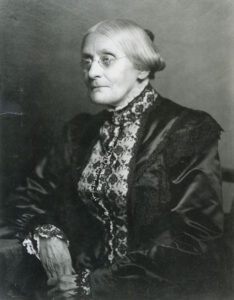
Early Life
Susan B. Anthony was born on February 15, 1820, in Adams, Massachusetts. She grew up in a Quaker family, where they believed everyone should be treated equally. Susan had seven brothers and sisters, and they were all taught to fight for fairness and justice.
Teaching Career
Susan B. Anthony started teaching in 1839 when she was just 19. She noticed something unfair. Even though she worked as hard as male teachers, she got paid less just because she was a woman. Susan spoke up and said that women should get the same pay as men for doing the same job. This was the start of her fight for fair treatment of women.
Meeting Frederick Douglass
After teaching for many years, Susan B. Anthony went back to her family. She met Frederick Douglass, who spent his life fighting for African American rights. Hearing him speak inspired Susan to join the fight to end slavery and to fight for African American rights.
Meeting Elizabeth Cady Stanton
In 1851, Susan met Elizabeth Cady Stanton, who along with Lucretia Mott, had organized the first women’s rights meeting in the U.S. three years earlier. Elizabeth convinced Susan to join the fight for women’s suffrage—The fight to give women the right to vote. Together, they became a powerful team working for equal voting rights. Susan and Elizabeth gave strong speeches, asking for women to have the right to vote. They traveled around the country to tell their message, inspiring others to join them in making things fairer for everyone.
15th Amendment
On February 26, 1869, the 15th Amendment was passed. This law gave African Americans the right to vote. Susan B. Anthony and Elizabeth Cady Stanton were disappointed because the amendment didn’t include women’s right to vote. In response, later that same year, Susan and Elizabeth formed the National Woman Suffrage Association. They wanted to change the Constitution to include women’s right to vote.
Arrested!
In 1872, Susan B. Anthony did something brave: she voted. However, because she was a woman, it was illegal for her to vote. She got arrested, had a trial, and was fined $100. Susan never paid the fine. Many people were upset about Susan’s arrest. Her arrest inspired many people to join the fight for Women’s Rights!
Declaration of Rights
In 1876, Susan led a protest during the United States’s 100th birthday. She gave a strong speech called the “Declaration of Rights,” written by Elizabeth Cady Stanton and Matilda Joslyn Gage. Susan said women should vote and be treated equally to men.
Legacy
Throughout her life, Susan B. Anthony dedicated herself to fighting for women’s rights. Sadly, Susan B. Anthony passed away in 1906, 14 years before women were finally granted the right to vote with the passing of the 19th Amendment in 1920. In honor of her tireless work, the 19th Amendment is often called the “Susan B. Anthony Amendment.” Susan B. Anthony’s legacy lives on today in many ways. You can find her face on the dollar coin, honoring her contributions to the fight for women’s rights. Her home in Rochester, New York, where she lived for many years, has been turned into a museum. Susan’s bravery and determination continue to inspire people around the world to stand up for equality and justice.